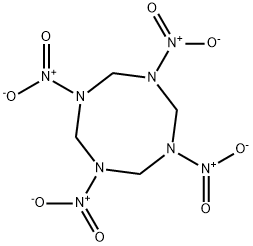Chemical Properties
Hexahydro-1,3,5-trinitro-S-triazine is a
white crystalline compound.
Chemical Properties
HMX (high-melting explosive) is a completely
N-nitrated, eight-membered heterocyclic ring compound analogous
to RDX. HMX has a molecular weight of 296.16 and a
melting point of 204°C. Virtually none of the toxicity information
on HMX was published, but it was reviewed by the
EPA.
Uses
HMX has uses similar to RDX, that is, as a base charge for
detonators and as an ingredient of bursting-charge and plastic
explosives by the military.
Uses
To implode fissionable material in
nuclear devices to achieve critical mass; as a
component of plastic-bonded explosives and
solid fuel rocket propellants and as burster
charges in military munitions.
Uses
In solid propellants and explosives.
Definition
ChEBI: A tetrazocane that is 1,3,5,7-tetrazocane in which the hydrogen atom attached to each of the nitrogens is replaced by a nitro group.
General Description
A white crystalline solid. Melting point 281°C. Practically insoluble in water. Water slurry mitigates explosion hazard. Used in solid propellants and explosives. The primary hazard is the blast effect and not flying projectiles and fragments.
Air & Water Reactions
Insoluble in water.
Reactivity Profile
HMX is a high explosive. May begin a vigorous reaction that culminates in a detonation if mixed with reducing agents, including hydrides, sulfides and nitrides. May explode in the presence of a base such as sodium hydroxide or potassium hydroxide even in the presence of water. Presence of metal oxides increases thermal sensitivity. Wetting reduces sensitivity toward detonation.
Health Hazard
Fire may produce irritating, corrosive and/or toxic gases.
Fire Hazard
MAY EXPLODE AND THROW FRAGMENTS 1600 meters (1 MILE) OR MORE IF FIRE REACHES CARGO.
Safety Profile
A poison by ingestion
and intravenous routes. An explosive.
Decomposes violently at 279OC. When
heated to decomposition it emits toxicfumes of NOx. See also EXPLOSIVES,
HIGH.
Potential Exposure
A potential danger to those involved
in the manufacture of this material and its handling in
munitions and solid-propellant manufacture. It is also used
as a rat poison; a powerful military explosive; a base
charge for detonators; and in plastic explosives.
Shipping
UN0483 Cyclotrimethylenetrinitramine, desensi-
tized or Cyclonite, desensitized or Hexogen, desensitized or
RDX, desensitized, Hazard Class: 1D; Labels: 1D-
Explosive (with a mass explosion hazard); D-Substances or
articles which may mass detonate (with blast and/or frag-
ment hazard) when exposed to fire. UN0072
Cyclotrimethylenetrinitramine, wetted or Cyclonite, wetted
or Hexogen, wetted or RDX, wetted with not ,15% water
by mass, Hazard Class: 1D; Labels: 1D-Explosive (with a
mass explosion hazard); D-Substances or articles which
may mass detonate (with blast and/or fragment hazard)
when exposed to fire.
Incompatibilities
Heat, physical damage, shock, and deto-
nators. Detonates on contact with mercury fulminate. Keep
away from other explosives, combustibles, oxidizers (such
as chlorates, nitrates, perchlorates, permanganates, perox-
ides; bromine, chlorine, and fluorine); reducing agents; and
aqueous alkaline solutions.
Waste Disposal
Pour over soda ash, neutralize
and flush to sewer with water. Also HMX may be recov-
ered from solid propellant waste.


